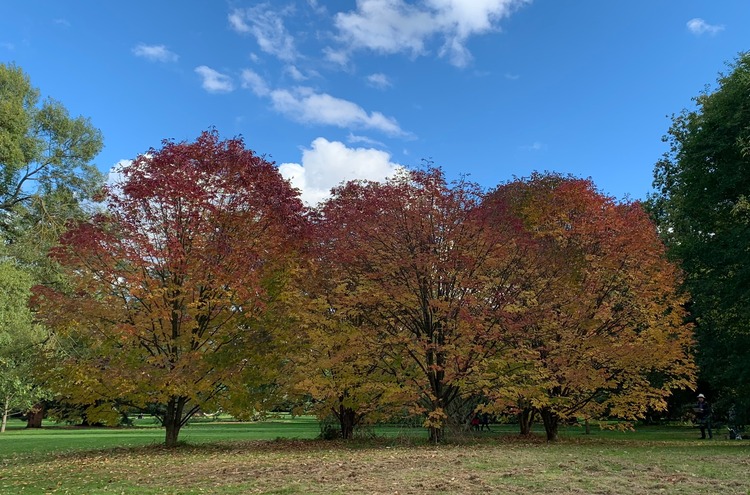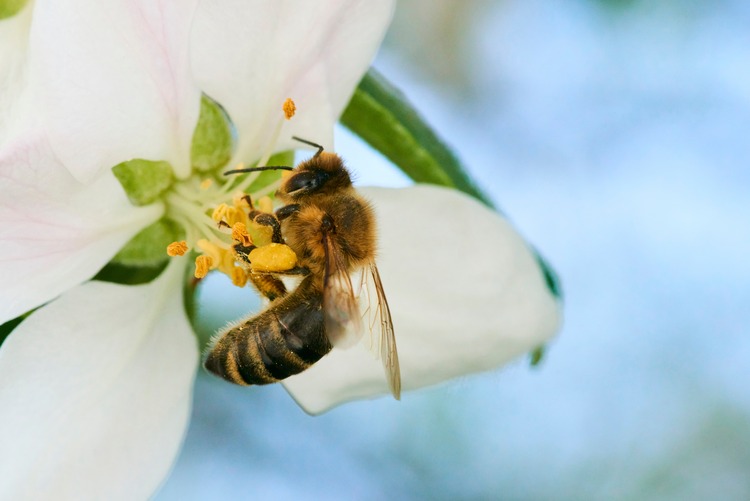
Whatever happened to the autumn flush? Climate change is throwing the seasons into turmoil
By
In the aftermath of Storm Babet, as roads and railway tracks are drained and roof shingles repaired, it can be easy to forget that this was not the first unusual weather for the season. Between the storm and an uncharacteristic heatwave, October has been a showcase of erratic weather phenomena in the UK.
We are not just experiencing unseasonal weather. Following a run of the hottest months on record, many trees in the Northern Hemisphere have been later than ever to change colour. Others are leaving out the characteristic explosion of reds and golds altogether and simply turning brown.
Changes in leaf colouration have been arriving later each year for several decades, according to a 2021 study on US Maples. Scientists found that the most visually striking feature of autumn is arriving between ten days to over a month later than in pre-industrial years. And other research indicates that when trees do start changing colour, air pollution and variable weather as a result of climate change could be causing less brilliant colour hues.
This year’s autumn has been especially unpredictable – in part because of the El Niño event unfolding in the Pacific Ocean, which is exacerbating the effects of global warming.
The season of change is changing – and it’s not the only time of year to do so. But why exactly are they changing? And how will it affect us?
Why is climate change affecting seasons?
Seasons are characterised by roughly consistent annual weather patterns, temperature ranges, and day lengths. Outside the tropics and polar regions of the earth, we generally describe the four seasons as spring, summer, autumn and winter and associate specific ecological and astronomical events with each time of year.
The seasons are related but different to astronomical seasons, which are more like units of time determined by Earth’s position in its orbit around the sun that, in turn, determine day lengths and certain climatic conditions on earth.
Climate change, caused by greenhouse gas emitted through human activities, is increasing average temperatures all throughout the year. These rising global temperatures influence local weather patterns and ecological responses, thereby altering or damaging the natural patterns we have come to expect from different seasons.
Autumn is starting later and becoming shorter
In UK primary schools, teachers will show graphics depicting the meteorological seasons. A circle is divided into four quarters – each representing a different season and roughly three months of a year. But as the effects of human-caused climate change become increasingly apparent, it is becoming harder for primary school kids to map these seasonal cycles into neat three-month segments.
A study has shown that summer in the Northern Hemisphere was around 17 days longer, whereas spring, autumn and winter were three to ten days shorter in 2011 compared to the 1950s. And the shift is set to continue: by 2100, winters could last less than two months, while summer would span around half the year, according to one model published in the Geophysical Research letters.
It follows that seasons are now starting and ending at different times. Spring is gradually arriving earlier in the year, while autumn is losing ground to summer, with a delayed start.
Changing seasons throw local ecosystems out of balance
While long summers might sound like no bad thing in the UK, it has far-reaching consequences for the natural world.
The life cycles and behaviours of many living creatures are tied to the conditions of specific seasons. These seasonal behaviours are often ‘synchronised’ across species. An Oxford study found that oak-leaf-eating caterpillars hatch at the same time as oaks bud in the spring, and great tits, who feed on the caterpillars, have a synchronised egg-laying period that means their young are born at ‘peak caterpillar time’.
‘There is evidence to suggest that great tits use large-scale cues such as temperature and day length to time their breeding,’ one of the studies authors, Ella Cole, noted. But the animals also use localised stimulus – such as the presence of early-stage caterpillars and young tree buds – to determine their egg-laying.
But as seasons contract or shift, these cues become increasingly disparate and interdependent species become unsynchronised – a phenomena known as ‘phenological mismatch’. In the UK, recent observations have pointed to a growing phenological mismatch between the flowering time of Bramley apple trees and the period in which their biggest pollinators – wild bees – are most active. Currently, the mismatch is luckily too small to have much of an effect on Bramley fruiting, but if the gap continues to grow, this could change.

Mismatches like these can have knock-on effects on interlocking food chains and, ultimately, entire ecosystems. They also affect humans, as many agricultural crops rely on the seasonal behaviours of plants and pollinators.
Seasonal weather is becoming less reliable
Some crop farmers are actually benefiting from the warmer temperatures, which result in longer growing seasons. Crops such as wheat and maize can be grown for longer periods or ‘double-cropped’ in areas at higher latitudes.
However, most crops are also facing increasingly challenging weather conditions at unexpected times. Rising global temperatures lead to more extreme weather events from freak droughts to excessive precipitation.
‘We are not having normal seasons any more,’ Lane Selman, an agricultural researcher at Oregon State University and founder of a seed-producer community called the Culinary Breeding Network, recently told the Guardian.
Freak weather can spell the end for sensitive staple crop plants like lettuce, cucumbers and tomatoes. And more generally, high temperatures early in the year can lead to ‘false springs’ – causing plants and trees to flower and bud before their pollinators are active, or make them vulnerable to a return of cooler weather.
Higher temperatures throughout autumn and winter can also mean some plants – such as hawthorns, plums, acorns and herbaceous perennials such as aquilegia, lavender, sage and wild rose – simply fail to germinate. Their seeds require ‘stratification’ – a shift from extremely cold to warmer temperatures to knock them out of a dormant state.
All the leaves are brown… but why?
Deciduous trees change colour as light – which they use for the photosynthesis of sugars – becomes more sparse and the production of the bright green chlorophyll stops, revealing deep yellow and red hues. The cooler weather and shorter days also reduce the production of auxin. The hormone is involved in maintaining the bond between the leaves and branching, and as it weakens, the leaves begin to fall.
However, some studies have found that higher levels of atmospheric carbon dioxide in the air are interrupting these processes.
Trees surrounded by elevated levels of greenhouse gases stay green for longer, as they can continue to produce sugars through photosynthesis for a longer period, even with less light. In Europe, atmospheric CO2 has risen by 13.5 per cent over the past 30 years, causing a delay in leaf fall of 1.3 to 1.8 days each decade.

The increased productivity is dangerous for trees because it stops them from setting buds in preparation for winter, leaving them vulnerable to frost.
The intensity of the colours could partly depend on early fall weather. Cool nights slow down chlorophyll production – the energy source for plants which gives them their green colour. Without a decline in temperature, the leaves do not change colour as gradually or vibrantly.
However, colour vibrancy is a difficult factor to study, and other theories for the fading autumn flush include changes in precipitation patterns and air pollution.
Can we reverse the effects of climate change and restore seasonal patterns?
Reversing the effects of climate change on the seasons will be extremely difficult in the short term. However, by drastically reducing greenhouse gas emissions and pursuing more sustainable agricultural practices, it is possible to slow and start mitigating the changes taking place.
This would require us to transition to renewable energies, cut out other uses of fossil fuels such as plastics and create more circular economies, in which materials that are not biodegradable are re-used.
By developing more strains of crops that are more resilient to extreme weather, investigating the uses of favourable fungi and plant relationships, or even adapting agricultural systems into indoor ‘vertical farms’, scientists and agriculturalists are also seeking short-term solutions to the challenge of changing seasons.
But without addressing the underlying cause of these shifts, we risk losing more than beautiful autumn vistas and farming traditions. We risk losing interdependent species, ecosystems and entire ways of human life that rely on the cyclical patterns of the four seasons.




